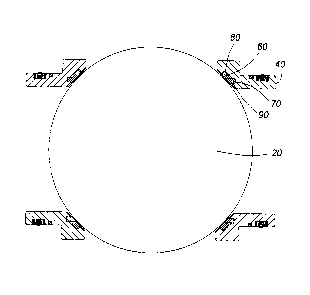Some of the information on this Web page has been provided by external sources. The Government of Canada is not responsible for the accuracy, reliability or currency of the information supplied by external sources. Users wishing to rely upon this information should consult directly with the source of the information. Content provided by external sources is not subject to official languages, privacy and accessibility requirements.
Any discrepancies in the text and image of the Claims and Abstract are due to differing posting times. Text of the Claims and Abstract are posted:
| (12) Patent Application: | (11) CA 2842354 |
|---|---|
| (54) English Title: | DELTA RING SEAL FOR BALL VALVE SEAT |
| (54) French Title: | BAGUE D'ETANCHEITE DELTA POUR SIEGE DE CLAPET A BILLE |
| Status: | Deemed Abandoned and Beyond the Period of Reinstatement - Pending Response to Notice of Disregarded Communication |
| (51) International Patent Classification (IPC): |
|
|---|---|
| (72) Inventors : |
|
| (73) Owners : |
|
| (71) Applicants : |
|
| (74) Agent: | PNC IP GROUP PROFESSIONAL CORPORATION |
| (74) Associate agent: | |
| (45) Issued: | |
| (22) Filed Date: | 2014-02-11 |
| (41) Open to Public Inspection: | 2015-08-11 |
| Examination requested: | 2014-02-11 |
| Availability of licence: | N/A |
| Dedicated to the Public: | N/A |
| (25) Language of filing: | English |
| Patent Cooperation Treaty (PCT): | No |
|---|
| (30) Application Priority Data: | None |
|---|
The present invention is a resilient delta ring seal for use in a seat for a
ball valve. The
seat has an annular opening for receiving and holding the delta ring seal
therein so that
an apex of the seal is pointed radially inward toward the ball valve and a
base of the
seal is orientated radially away from the ball valve. The seal base is wider
than the apex
and the apex protrudes beyond the opening and toward the valve. The seal apex
is
truncated to level the apex while the seal still extends beyond the opening
and toward
the valve.
Note: Claims are shown in the official language in which they were submitted.
Note: Descriptions are shown in the official language in which they were submitted.

2024-08-01:As part of the Next Generation Patents (NGP) transition, the Canadian Patents Database (CPD) now contains a more detailed Event History, which replicates the Event Log of our new back-office solution.
Please note that "Inactive:" events refers to events no longer in use in our new back-office solution.
For a clearer understanding of the status of the application/patent presented on this page, the site Disclaimer , as well as the definitions for Patent , Event History , Maintenance Fee and Payment History should be consulted.
| Description | Date |
|---|---|
| Application Not Reinstated by Deadline | 2018-02-13 |
| Time Limit for Reversal Expired | 2018-02-13 |
| Inactive: Abandoned - No reply to s.30(2) Rules requisition | 2017-07-10 |
| Deemed Abandoned - Failure to Respond to Maintenance Fee Notice | 2017-02-13 |
| Inactive: Report - QC passed | 2017-01-09 |
| Inactive: S.30(2) Rules - Examiner requisition | 2017-01-09 |
| Amendment Received - Voluntary Amendment | 2016-09-16 |
| Amendment Received - Voluntary Amendment | 2016-09-15 |
| Inactive: S.30(2) Rules - Examiner requisition | 2016-03-15 |
| Inactive: Report - QC passed | 2016-03-14 |
| Maintenance Request Received | 2016-02-08 |
| Inactive: Agents merged | 2015-11-11 |
| Inactive: Adhoc Request Documented | 2015-11-10 |
| Inactive: Delete abandonment | 2015-11-10 |
| Amendment Received - Voluntary Amendment | 2015-09-14 |
| Inactive: Abandoned - No reply to s.30(2) Rules requisition | 2015-09-14 |
| Inactive: Cover page published | 2015-08-17 |
| Application Published (Open to Public Inspection) | 2015-08-11 |
| Inactive: S.30(2) Rules - Examiner requisition | 2015-03-13 |
| Inactive: Report - No QC | 2015-03-05 |
| Inactive: IPC assigned | 2014-03-19 |
| Inactive: First IPC assigned | 2014-03-19 |
| Inactive: IPC assigned | 2014-03-19 |
| Letter Sent | 2014-02-24 |
| Filing Requirements Determined Compliant | 2014-02-24 |
| Inactive: Filing certificate - No RFE (bilingual) | 2014-02-24 |
| Application Received - Regular National | 2014-02-19 |
| Inactive: Pre-classification | 2014-02-11 |
| Request for Examination Requirements Determined Compliant | 2014-02-11 |
| All Requirements for Examination Determined Compliant | 2014-02-11 |
| Small Entity Declaration Determined Compliant | 2014-02-11 |
| Abandonment Date | Reason | Reinstatement Date |
|---|---|---|
| 2017-02-13 |
The last payment was received on 2016-02-08
Note : If the full payment has not been received on or before the date indicated, a further fee may be required which may be one of the following
Please refer to the CIPO Patent Fees web page to see all current fee amounts.
| Fee Type | Anniversary Year | Due Date | Paid Date |
|---|---|---|---|
| Request for examination - small | 2014-02-11 | ||
| Application fee - small | 2014-02-11 | ||
| MF (application, 2nd anniv.) - small | 02 | 2016-02-11 | 2016-02-08 |
Note: Records showing the ownership history in alphabetical order.
| Current Owners on Record |
|---|
| CHARLES LO CICERO |
| Past Owners on Record |
|---|
| None |